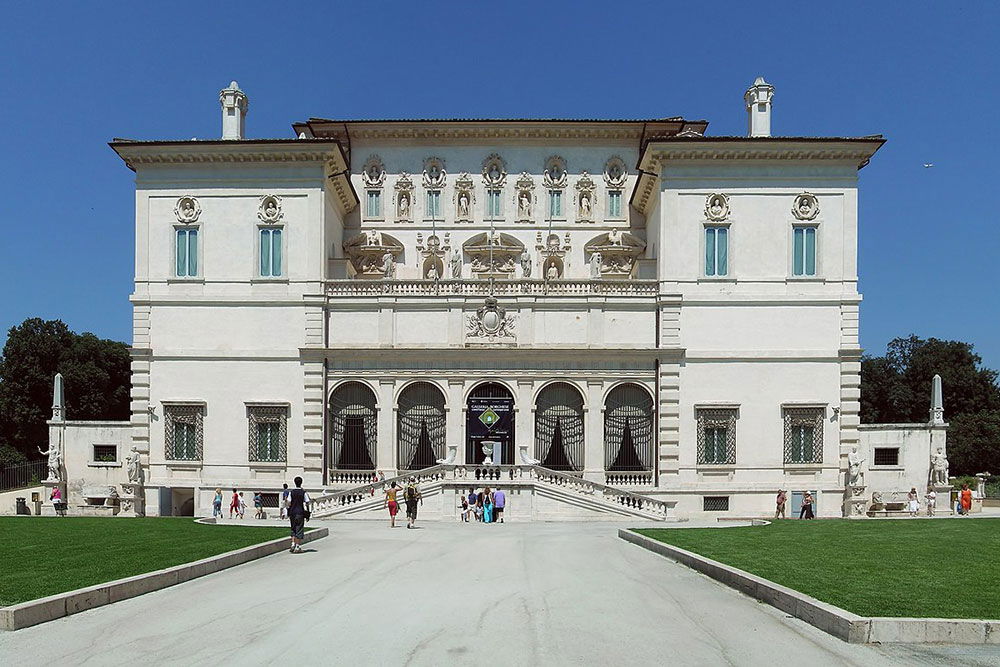
Tucked away in the lush green expanse of the Villa Borghese gardens, the Galleria Borghese is a rare gem that combines breathtaking art, opulent architecture, and a fascinating glimpse into the personal taste of one of Rome’s most powerful families. Unlike many larger museums that overwhelm with sheer size, the Galleria Borghese offers an intimate, immersive experience, one that draws art lovers from around the world.
The Galleria Borghese is housed in the Villa Borghese Pinciana, a splendid 17th-century villa originally built by Cardinal Scipione Borghese, the powerful nephew of Pope Paul V. A passionate art collector and a patron of Caravaggio and Bernini, Scipione envisioned a showcase for his rapidly growing art collection that would also serve as a symbol of status, intellect, and Roman grandeur.
The villa was constructed between 1609 and 1613, designed by Flaminio Ponzio and later completed by Giovanni Vasanzio, blending Mannerist and early Baroque architecture. From the very beginning, the space was meant not as a residence, but as a theatrical setting for art and entertainment.
The museum houses one of the finest collections of Italian Renaissance and Baroque art in the world. Each room is a jewel box of visual delight, not only because of the paintings and sculptures but also the elaborately frescoed ceilings, mosaics, and marble inlay floors.
Here are some of the highlights that make the Galleria Borghese a must-visit:
No visit to the Galleria is complete without standing in awe before Bernini’s dynamic sculptures, which seem to defy the limits of marble. The museum is home to some of his most celebrated masterpieces:
Apollo and Daphne (1622–25) – This astonishing work captures the moment Daphne transforms into a laurel tree, with her fingers turning to leaves and her body sprouting bark.
The Rape of Proserpina (1621–22) – A dramatic and emotional sculpture where Pluto abducts Proserpina, rendered with astonishing realism, right down to the indent of his fingers on her soft skin. David (1623–24) – Unlike Michelangelo’s poised version, Bernini’s David is caught mid-action, twisting his body and biting his lip with concentration.These works were all commissioned by Scipione Borghese and remain some of the greatest examples of Baroque sculpture in existence.
Galleria Borghese boasts one of the most impressive Caravaggio collections in the world, offering a firsthand look at his revolutionary use of light and shadow. Key works include:
Boy with a Basket of Fruit (1593–94) – A youthful and sensuous portrait filled with symbolic richness.
David with the Head of Goliath (1610) – A haunting late work, believed to be a reflection on mortality and sin, with the severed head of Goliath said to be a self-portrait.
Madonna and Child with St. Anne (1605–06) – An intense and controversial interpretation that once shocked the clergy for its raw realism.
The collection also includes exceptional works by:
Raphael – *The Deposition(1507), a deeply emotional piece showing Christ being taken down from the cross.
Titian – *Sacred and Profane Love(c. 1514), a poetic and mysterious allegory of duality in womanhood.
Correggio, Rubens, Bellini, and Dosso Dossi – Each contributing to the layered richness of the museum’s offerings.
The museum is designed to be explored in two levels:
The ground floor features sculpture, ancient Roman artifacts, and early Baroque pieces.
The upper floor focuses on paintings, offering quieter, more contemplative rooms with stunning masterpieces on every wall.
Every room is meticulously curated, allowing the artworks to shine in natural light or gentle artificial illumination. Visitor numbers are strictly limited, reservations are mandatory, and entrance is timed, making the experience feel exclusive and serene.
After your visit, you can stroll through the Villa Borghese gardens, one of Rome’s most beloved public parks. From its scenic pathways and fountains to panoramic views over Piazza del Popolo and the Pincian Hill, the setting complements the artistic immersion with a peaceful escape into nature.
You can even rent a bicycle or rowboat, or stop at the nearby Piazza di Siena, where equestrian events are sometimes held.
Galleria Borghese is not just a museum, it is a sensory journey through the golden age of art, where sculpture breathes, paintings pulse with life, and every hallway tells a story. It offers a uniquely Roman blend of classical refinement and dramatic flair, echoing the passions of the family that built it and the genius of the artists it celebrates.
Whether you're an art historian, a first-time visitor, or a returning admirer, Galleria Borghese promises an unforgettable encounter with some of the greatest masterpieces in human history, all within the intimate walls of a villa that feels frozen in time.

More Details